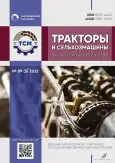Эколого-мелиоративный способ обработки почвы
- Авторы: Тарасенко Б.Ф.1, Дробот В.А.1, Соколова В.А.2, Ореховская А.А.3
-
Учреждения:
- Кубанский государственный аграрный университет им. И.Т. Трубилина
- Военная академия связи им. Маршала Советского Союза С.М. Буденного
- Белгородский государственный аграрный университет им. В.Я. Горина
- Выпуск: Том 89, № 5 (2022)
- Страницы: 319-324
- Раздел: Экологически чистые технологии и оборудование
- URL: https://journal-vniispk.ru/0321-4443/article/view/125936
- DOI: https://doi.org/10.17816/0321-4443-106584
- ID: 125936
Цитировать
Полный текст
Аннотация
Обоснование. Степные районы Северного Кавказа, Поволжье и области Центрально-Черноземной – зоны недостаточного и неустойчивого увлажнения, подвержены действию сильных ветров, которые разрушают и выдувают почву, вызывают пыльные бури, повреждают посевы и нередко уничтожают их на больших площадях. Установлено, что основными очагами возникновения пыльных бурь были площади, вспаханные обыкновенными отвальными орудиями. В связи с этим приобрела большое значение широко применяемая в Северном Казахстане и Западной Сибири безотвальная (плоскорезная) обработка почвы с сохранением большей части пожнивных остатков на поверхности почвы. При этом обработка почвы чизельными культиваторами или плугами, а также рыхлителями-щелевателями со стрельчатыми рыхлящими лапами позволяет в 1,3-1,5 раза уменьшить общие энергозатраты, а также улучшает агрофизические свойства почвы и повышает урожайность культур.
Цель работы – разработка безотвальной почвозащитной технологии, способствующей накоплению влаги и повышению урожая.
Материалы и методы. Способ включает безотвальную обработку почвы совместно с нарезанием щелей и образованием полостей. Устройство состоит из навесной рамы с опорными колесами и рабочими органами. Безотвальные рабочие органы установлены в шахматном порядке и содержат выполненные С -образные стойки с закрепленными на конце долотами и по бокам плоскорезными трапецеидальными полулапами. Сзади стоек зафиксированы дренеры, трапецеидальные полулапы в передней части закреплены шарнирно на осях, жестко зафиксированных по бокам стоек, а в задней части имеют кинематическую связь с механизмом качающейся шайбы, связанной, в свою очередь, с валом отбора мощности энергетического средства.
Результаты. Рабочий процесс способа накопления влаги в почве осуществляют следующим образом: после уборки урожая предшествующей культуры производят лущение, а затем производят поделку борозд с одновременным безотвальным рыхлением, при этом на глубине 30–60 см создаются полости прямоугольного сечения, причем стенки полостей утрамбованы. Благодаря чему талая вода через борозды поступает и собирается в полостях большего объема и удерживается благодаря утрамбованным стенкам длительное время. Использование полостей большего объема позволит увеличить количество накопленной влаги, которая будет способствовать увеличению количества урожая.
Заключение. Предложен усовершенствованный способ. Новизна способа заключается в том, что образование полостей производят на глубине от 30 до 60 см за счет низкочастотных колебаний при частоте 1 ход в секунду плоскорезных трапецеидальных полулап с боков стойки, а уплотнение стенок полостей осуществляют путем воздействия высокочастотных колебаний с частотой 250 Гц при помощи роликовых элементов. Использование полостей большего объема позволит увеличить объём накопленной влаги, которая будет способствовать увеличению количества урожая.
Полный текст
Открыть статью на сайте журналаОб авторах
Борис Федорович Тарасенко
Кубанский государственный аграрный университет им. И.Т. Трубилина
Email: b.tarasenko@inbox.ru
ORCID iD: 0000-0001-9957-5979
SPIN-код: 7415-7870
профессор, д.т.н., профессор кафедры ремонта машин и материаловедения
Россия, КраснодарВиктор Александрович Дробот
Кубанский государственный аграрный университет им. И.Т. Трубилина
Email: viktor.drobot.85@mail.ru
ORCID iD: 0000-0002-3136-6481
SPIN-код: 7889-3176
доцент, к.т.н., доцент факультета гидромелиорации
Россия, КраснодарВиктория Александровна Соколова
Военная академия связи им. Маршала Советского Союза С.М. Буденного
Email: sokolova_vika@inbox.ru
ORCID iD: 0000-0001-6880-445X
SPIN-код: 5116-5102
доцент, к.т.н., преподаватель кафедры технического обеспечения связи и автоматизации
Россия, Санкт-ПетербургАлександра Александровна Ореховская
Белгородский государственный аграрный университет им. В.Я. Горина
Автор, ответственный за переписку.
Email: orehovskaja_aa@bsaa.edu.ru
ORCID iD: 0000-0001-8149-7191
к.с.-х.н., начальник отдела по работе с грантами и научно-образовательными центрами
Россия, Белгородская область, п. МайскийСписок литературы
- Тарасенко Б.Ф., Дробот В.А. Эколого-мелиоративные методы подготовки почвы: монография. Краснодар: КубГАУ, 2021.
- Тарасенко Б.Ф., Дробот В.А. Новая полевая установка для динамометрирования и результаты оценки тяговых сопротивлений почвообрабатывающего рабочего органа // Тракторы и сельхозмашины. 2014. Т. 81, № 12. С. 10–12. doi: 10.17816/0321-4443-65471
- Оськин С.В., Тарасенко Б.Ф., Дробот В.А. Применение имитационного моделирования для оптимизации состава почвообрабатывающих агрегатов при возделывании зерновых культур // Тракторы и сельхозмашины. 2015. Т. 82, № 7. С. 24–26. doi: 10.17816/0321-4443-66037
- Тарасенко Б.Ф., Дробот В.А., Цыбулевский В.В., и др. Оптимизация параметров долота чизельного рабочего органа // Сельский механизатор. 2019. № 3. С. 4–6.
- Патент РФ № 2468558 / Тарасенко Б.Ф., Цыбулевский В.В., Моргунов С.А. Устройство для безотвальной обработки почвы. Режим доступа: https://new.fips.ru/iiss/document.xhtml?faces-redirect=true&id=7779cbbb2901b45a94d8cfce0148d90a
- Патент РФ № 2404558 / Тарасенко Б.Ф., Медовник А.Н., Дробот В.А. и др. Устройство для безотвальной обработки почвы. Режим доступа: https://new.fips.ru/iiss/document.xhtml?faces-redirect=true&id=936471c9d2ff1f798dd8b56f077804a1
- Патент РФ № 2457645 / Б.Ф. Тарасенко, М.И. Чеботарев, В.В. Цыбулевский и др. Устройство для щелевания почвы. Режим доступа: https://new.fips.ru/iiss/document.xhtml?faces-redirect=true&id=b73ff20c9482a7179861e893cbf26a63
- Авторское Свидетельство СССР № 1020011 / 30.05.1983 Бюл. № 42. Циммерман А.Е., Шутов Ю.И. Орудие для противоэрозионного щелевания почвы. Режим доступа: https://patents.su/3-1020011-orudie-dlya-protivoehrozionnogo-shhelevaniya-pochvy.html
- Патент РФ № 2518254 / Тарасенко Б.Ф., Маслов Г.Г., Чеботарев М.И. и др. Способ накопления влаги в почве и устройство для его осуществления. Режим доступа: https://new.fips.ru/iiss/document.xhtml?faces-redirect=true&id=358743af52eca93dbc2759c5a4249857
Дополнительные файлы








